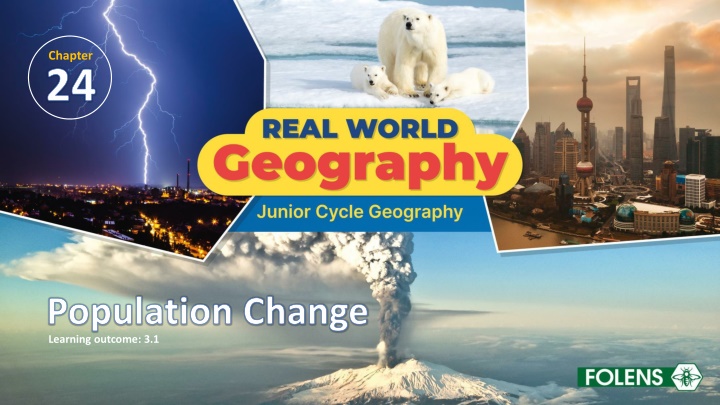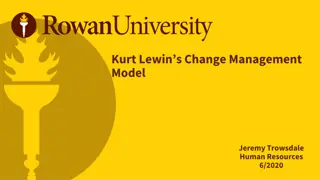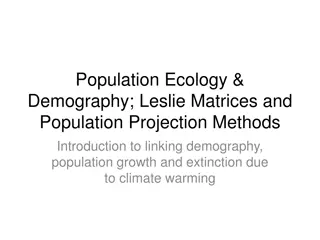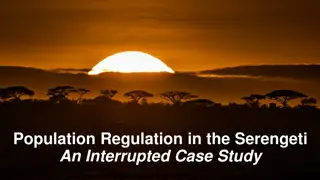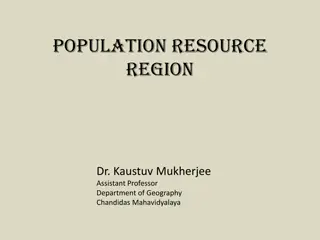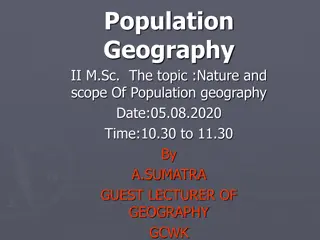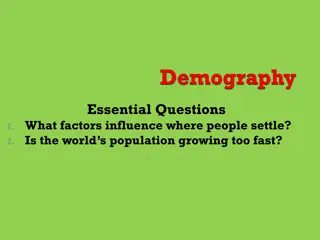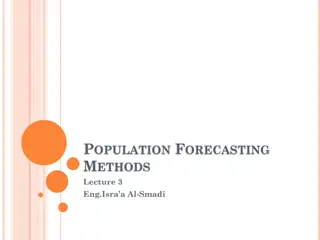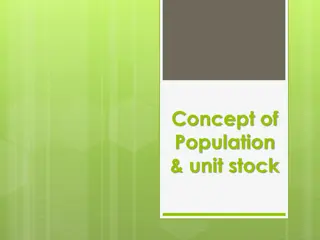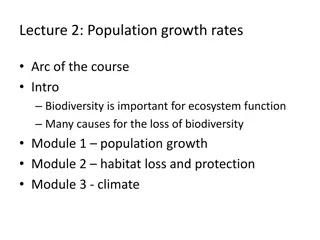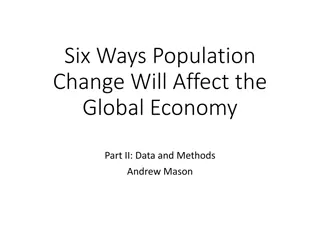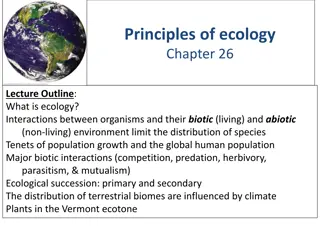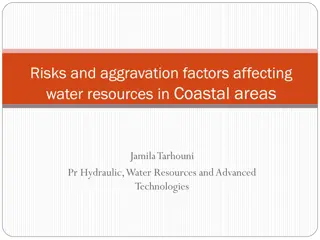Factors Influencing Population Change in Chapter 24
This chapter explores key factors affecting population change including food supply, technology, healthcare, war, status of women, and education. It discusses how improved technology, healthcare advancements, and food availability impact population growth, as well as the demographic transition model and sustainable population issues.
Download Presentation

Please find below an Image/Link to download the presentation.
The content on the website is provided AS IS for your information and personal use only. It may not be sold, licensed, or shared on other websites without obtaining consent from the author.If you encounter any issues during the download, it is possible that the publisher has removed the file from their server.
You are allowed to download the files provided on this website for personal or commercial use, subject to the condition that they are used lawfully. All files are the property of their respective owners.
The content on the website is provided AS IS for your information and personal use only. It may not be sold, licensed, or shared on other websites without obtaining consent from the author.
E N D
Presentation Transcript
Chapter 24 Population Change Learning outcome: 3.1
At the end of this chapter, you will be able to: 24.1 Explain the six factors affecting population change. 24.2 Describe the different stages of the Demographic Transition Model. 24.3 Describe the trends in the world s population over time. 24.4 Explain population distribution and density 24.5 Compare population change in Tanzania and Ireland. 24.6 Describe sustainable issues related to population.
24.1 Explain the six factors affecting population change. What things influence population growth? Improved technology The status of women Education
24.1 Explain the six factors affecting population change. Food supply 1. When there is more and better food available, the population increases. o Good nutrition means people live longer and healthier lives. 2. Lack of food, e.g. famine, causes the population to decrease. o Ireland during the Famine, 1845 52
24.1 Explain the six factors affecting population change. Improved technology 1.Modern farm machinery, artificial fertilisers and pesticides have all increased the amount of food that can be grown. o Modern conveniences have made life easier. o People live longer and the population increases. 2. An absence of modern conveniences makes life harder in some countries. A poorer quality of life leads to higher death rates. o Sometimes improved technology, for example, war technology, can lead to a decrease in population.
24.1 Explain the six factors affecting population change. Health care 1.When the health of a country improves, the death rate decreases, and population size increases. o Vaccines Polio, smallpox, Covid o Medical devices Heart valves, respirators 2. An absence of good healthcare leads to a higher death rate and a decrease in the size of a population. o AIDS crisis in southern Africa
24.1 Explain the six factors affecting population change. War 1. War causes the death of large numbers of people. o Economic activity is disrupted. o Harvesting and transporting of food are affected. o Many people die from starvation and exposure. 2. The population often increases rapidly after a war. o There is a baby boom . Image: Deutsche Fotothek, CC BY-SA 3.0 de, https://commons.wikimedia.org/w/index.php?curid=6542862
24.1 Explain the six factors affecting population change. The status of women 1. In traditional societies, women often do not work outside the home, and they are expected to have many children. 2. In modern societies, women have more control and choice over how they live their lives. o This includes being able to decide how many children they have. o This reduces the number of children they have.
24.1 Explain the six factors affecting population change. Education 1.Where there is less education available, the population increases. o Females leave school early. o They have children at a younger age o They have more children over their lifetime. 2. The longer people stay in education, the fewer children they tend to have. o This reduces the size of the population. o Women who stay in education longer usually have fewer children.
24.1 Explain the six factors affecting population change. 1. Why is good nutrition important? 2. Why have modern conveniences improved people s standard of living? 3. What are vaccines, and how do they affect population growth? 4. How have improved women s rights affected population growth? 5. Explain one way level of education reduces population growth.
24.1 Explain the six factors affecting population change. Going further 1 1. You examine each factor affecting population separately. What can happen to population if you combine two or three factors at the same time? 2. Do a quick class survey. How many children do each of your classmates think they might like to have in future? Why that number of children? 3. Why are vaccines important?
24.1 Explain the six factors affecting population change. Go to Section 24.1 on page 132 of your Skills Book.
24.2 Describe the different stages of the Demographic Transition Model. Demographic Transition Model
24.2 Describe the different stages of the Demographic Transition Model. Stage 1: High fluctuating stage Description: Birth rates are high and fluctuating. Death rates are high and fluctuating. Population size is low and stationary (doesn t change). Explanation: Famine, disease and war cause high death rates, which cancel out high birth rates. High birth rates occur as parents have more children to ensure some survive to adulthood. In Stage 1, a country is poorly developed. At present, no country is at Stage 1.
24.2 Describe the different stages of the Demographic Transition Model. Stage 2: Early expanding stage Description: The birth rate remains high. The death rate falls quickly. The population size increases rapidly. Explanation: The economy of a country starts to grow. There is increased food, improved water supplies, and improvements in medicine and public health cause the death rate to decrease. A large gap grows between the birth rate and death rate, so the population grows quickly. Afghanistan and Tanzania are currently in this stage of the population cycle.
24.2 Describe the different stages of the Demographic Transition Model. Stage 3: Late expanding stage Description: The birth rate begins to decrease rapidly. The death rate continues to decrease but not as quickly. The size of the population continues to increase but much more slowly. Explanation: People want to protect their standard of living so start to plan the size of their family. This causes the birth rate to decrease. There are fewer improvements in food and water supplies and healthcare, so the death rate only decreases gradually. The gap between birth and death rates is shrinking, so population growth decreases. Botswana and Colombia are currently in this stage of the population cycle.
24.2 Describe the different stages of the Demographic Transition Model. Stage 4: Low fluctuating stage Description: Birth rates decrease to a low level but fluctuate. Death rates are low but fluctuating. Population size reaches a maximum and stops increasing. Explanation: The economy of a country is developed. Healthcare, food and water supplies are excellent, so people live long lives and the death rate is low. Having children is more costly than in developing countries and people want to protect their standard of living, so the birth rate is low. Ireland is currently in this stage of the population cycle.
24.2 Describe the different stages of the Demographic Transition Model. Stage 5: Senile stage Description: The death rate is low and fluctuating. The birth rate decreases below the death rate. The population size begins to decrease. Explanation: The economy of a country is well developed. New improvements in medicine and healthcare are rare, so the death rate doesn t change from Stage 4. People decide to have fewer children. One-child families are more common, so the birth rate is lower than the death rate. There is a natural decrease so the population size decreases. Germany and Italy are currently in this stage of the population cycle.
24.2 Describe the different stages of the Demographic Transition Model.
24.2 Describe the different stages of the Demographic Transition Model. 1. Name the five stages of the Demographic Transition Model. 2. How many countries are presently in stage 1 of the model? 3. At which stage of the model does population grow the fastest? 4. Why does the size of the population decrease in stage 5? 5. Why is the Demographic Transition Model useful to governments?
24.2 Describe the different stages of the Demographic Transition Model. Going further 2 1. Do some countries have high birth rates because they are poor, or are they poor because they have high birth rates? 2. What is the connection between the Demographic Transition Model and population pyramids? 3. What does the Demographic Transition Model tell us about the health of a country?
24.2 Describe the different stages of the Demographic Transition Model. Go to Section 24.2 on page 133 of your Skills Book.
24.3 Describe the trends in the worlds population over time. Examine the graph opposite. What trend is shown by the graph?
24.3 Describe the trends in the worlds population over time. 1. Name two countries with rapid population growth. 2. Which term best describes Ireland s population growth? 3. Which continent experiences rapid growth the most?
24.3 Describe the trends in the worlds population over time. Go to Section 24.3 on page 135 of your Skills Book.
24.4 Explain population distribution and density. Population distribution describes where people live. The world s population is unevenly distributed across the surface of the Earth. Think-Pair-Share Pair up with a classmate. What places on Earth are people less likely to live in? Why? Where are people more likely to live?
24.4 Explain population distribution and density. Examine the map opposite. 1. Which places are densely populated? 2. What do they have in common? 3. Which places are sparsely populated? 4. What do they have in common?
24.4 Explain population distribution and density. Economic development Relief History Most people live below 200 m, as the land is easier to access and to build on. Most of the world s major cities are located on low-lying coasts and river floodplains. The voyages People have abandoned rural areas in search of work in cities. This has led to the growth of cities. More than 50 per cent of the world s population live in urban areas. Cities also have more facilities, services and opportunities, which attract people seeking a better standard of living. of discovery led to events such as Portugal s influence in Tanzania. The plantations and poor economic development led to emigration from Ireland. These have all impacted on the population density of regions. Climate Resources Ninety per cent of the world s population lives in the northern hemisphere between latitudes 20 and 60 , as the climate is more favourable. It is neither too hot nor too cold. Intensive agriculture is possible in this region, and over time the increased food supply increased the population living there. Population densities are high in Europe, as this was the location of large deposits of coal and iron ore. These resources drove the Industrial Revolution in the nineteenth century. Workers and their families were attracted to locations with resources.
24.4 Explain population distribution and density. Go to Section 24.4 on page 136 of your Skills Book.
24.5 Compare population change in Tanzania and Ireland. Tanzania is a developing country. It has a population of 62 million. Poverty has impacted on its population. People have more children to ensure that some survive to adulthood.
24.5 Compare population change in Tanzania and Ireland. Tanzania s population is growing at 2.68 per cent per year. 45% of the population is under 15 years of age. Only 3% is above 64 years of age. The highest population density is in Dodoma and Dar es Salaam. The rate of population increase is slowing down.
24.5 Compare population change in Tanzania and Ireland. Population pyramid of Ireland, 1841 Ireland s population was over 8 million in 1845. The Famine and emigration reduced the population to 5.4 million by 1871. The population continued to decrease until 1961.
24.5 Compare population change in Tanzania and Ireland. Emigration returned between the 1980s and 1994. The population increased during the Celtic Tiger between 1994 and 2008. Emigration occurred again between 2008 and 2013. Ireland s birth rate is low (1.12 per cent in 2020), but immigration has created a net increase in the population. Net migration in Ireland, 2009 2020
24.5 Compare population change in Tanzania and Ireland. Examine the map opposite. 1. Which places in Ireland have the highest population density? Explain why. 2. Which areas have lower population density? Explain why.
24.5 Compare population change in Tanzania and Ireland. Going further 3 1. Why is the status of women important in improving the quality of life in developing countries? 2. Ireland has a history of emigration. In your class, discuss your experience of emigration. 3. How could the government rebalance the distribution of population in Ireland?
24.5 Compare population change in Tanzania and Ireland. Go to Section 24.5 on page 138 of your Skills Book.
24.6 Describe sustainable issues related to population. If a region does not have enough of a particular resource, it can trade with other regions to get the resources it needs. If a region has more people than resources, or it cannot access resources (by trading), we say it is overpopulated. A shortage of resources in one region will cause people to migrate to another region. o Climate change is increasing droughts and floods in many regions across the world. This affects a region s ability to grow food. People in poorer countries suffer the effects of extreme climate more than people in richer countries. This causes migration, as people move in order to survive.
Assess your progress Go to page 141 of your Skills Book and assess your progress. 24.1 Explain the six factors affecting population change. 24.2 Describe the different stages of the Demographic Transition Model. 24.3 Describe the trends in the world s population over time. 24.4 Explain population distribution and density 24.5 Compare population change in Tanzania and Ireland. 24.6 Describe sustainable issues related to population. Identify any gaps in your learning. Use the Rapid Revision on page 307 of your textbook to jog your memory.
